
Although Netflix (NASDAQ:$NFLX) just announced one of its best quarter reports so far — in its second quarter alone, the company saw 1.1 million new subscribers in the U.S. and 4.1 million international new subscribers — it is expecting a negative free cash flow of around $2 billion to $2.5 billion. In a letter to shareholders, Netflix’s management addressed this fact, stating, “We will deploy increased capital in content, particularly in owned originals, and, as we have said before, we expect to be FCF negative for many years.”
So how does Netflix produce positive net income with negative free cash flow? Below is some information to help investors understand how Netflix pulls this off.
Amortization of expenses
Netflix often pays more in cash for both original and licensed content than what shows up on its income statement as an expense. This is because they pay off content expenses bit by bit based on how useful the life of the content — a licensed movie or TV show can have a useful life anywhere from six months to 10 years.
For most of its content licenses, however, Netflix accelerates its amortization schedule. For original content, Netflix typically amortizes about 90% of the production cost over four years. Some of its original TV shows are expensed when they air if the useful life is shorter relative to other content.
Amortization of content expenses allows Netflix to hide just how much cash it’s spending up front for both original and licensed content. While the expenses certainly show in Netflix’s cash flow statement, it doesn’t make a dent in other things that catch more attention from investors, like earnings per share.
Moving into in-house production
Netflix’s projected negative free cash flow was probably not a big surprise to its investors. For the last three years, Netflix has had a negative free cash flow — a fact that aligns with the company’s increasing focus on producing more original content after early successes of productions such as House of Cards and Orange is the New Black. From management’s comment after Netflix’s second quarter reports, it looks like the company will continue to grow its original content even more aggressively.
Moreover, Netflix has begun to produce more of its original series in-house instead of giving production companies exclusive first-run streaming rights. While this move allows Netflix to have more control of its content as well as the ability to license intellectual property as it wishes, it costs the company a lot more up front. Netflix will also be able to pay in cash up front way before the content goes public. As such, this cost won’t be in its income statement but will kill cash flow statement as the payments occur.
Netflix’s further pursuit of sustaining and creating more original productions will further widen the gap between the company’s cash burn and content expense. Investors are advised to keep an eye on the company as it makes the shift from licensed originals and second-run productions to creating original content in-house. Eventually, the cost that shows up on Netflix’s cash flow statement will show up on its income statement.
Other content obligations
Although Netflix is pushing for more original content, investors shouldn’t forget that the company also holds a number of long-term contracts with big media companies like Disney to distribute licensed content in the future. Any of the content that does not start streaming on Netflix for another year does not show up on Netflix’s balance sheet. Instead, the company outlines the cost of this content in another form as additional obligations. Its current additional cost obligations after next year are $8.7 billion.
While other big media companies, like Disney’s ESPN, also practice holding future content obligations, what’s concerning with Netflix’s strategy is the fact that sometimes it will make deals for content it doesn’t know the exact price of. For example, Netflix can reach a deal with Disney to stream all its new feature films over the next few years. However, Disney could make any number of films for the next few years, so the exact cost Netflix will have to pay for this content is not yet set in stone. Similarly, Netflix will often agree to stream all seasons of an ongoing TV show without knowing how many seasons the TV show will run for.
The cost of these additional obligations doesn’t usually show up in Netflix’s earnings reports.
Saved by subscriber growth
Netflix’s strategy of amortizing its content spending has allowed for positive subscriber growth, especially looking at its 2017 second quarter reports. For now, its expenses aren’t showing up in its income expenses and thus earnings reports are quite strong.
Netflix will need to rapidly keep up their subscriber growth so that when their expenses finally reach the income statement, the company’s bottom line will still show progress. As Netflix continues to aggressively pursue original productions and uphold its long-term contracts, the company will keep seeing negative free cash flow.
Featured Image: twitter












